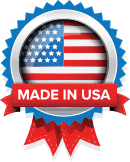PVDF’s properties make it highly versatile and effective for countless applications. With its superior corrosion resistance, high-temperature tolerance, and minimal water and gas absorption, PVDF is one of the most effective materials used in a variety of industrial purposes.
Our PVDF machining capabilities include high-precision fabrication techniques, such as:
- CNC machining: Our software-controlled cutting, drilling, tapping, forming, and other CNC machining functions shape various PVDF materials with high precision.
- Grinding: Grinding is often used in conjunction with milling to remove plastic chips, flashing, burrs, and surface defects. Unlike milling, however, grinding does not use intermittent cutting, but rather continual contact removal to correct these imperfections and create highly functional plastic parts that stringently adhere to design specifications.
- Bending: Using heaters and ovens, we can precisely form or line-bend PVDF.
- Welding
From prototyping to large-production runs, we consistently achieve precision tolerances within ±0.005”.
PDVF FAQ’s
What is PVDF?
Polyvinylidene fluoride (PVDF), known by its tradename Kynar®, is a highly purified thermoplastic made from high-molecular-weight fluorocarbons. PVDF is commonly found in many industries, such as pharmaceutical, biomedical, and semiconductor, due to its impressive range of properties.
What are the Different Material Types?
Two types of PVDF are available, each with its own material properties:
- Homopolymer PVDF has high mechanical strength and hardness, with a higher heat-deflection threshold than copolymer PVDF.
- Copolymer PVDF is less rigid than homopolymer PVDF but better resists impact damage and stress cracking.
Properties
| Units | ASTM Test | Homopolymer PVDF | |
|---|---|---|---|
| Tensile Strength | psi | D638 | 7,800 |
| Flexural Modulus | psi | D790 | 310,000 |
| Izod Impact (notched) | ft-lbs/in of notch | D256 | 3.0 |
| Heat Deflection Temperature @ 264 psi | °F | D648 | 235 |
| Maximum Continuous Service Temperature in Air | °F | - | 302 |
| Water Absorption (24-hr immersion) | % | D570 | 0.02 |
| Coefficient of Linear Thermal Expansion | in/in/°F x 10-5 | D696 | 7.1 |
What is PVDF Used For?
- Automotive parts
- Pump and valve parts
- Processing equipment components
- Electronic components
- Packaging materials
- Cast films
- Custom plastic tanks
What are the Advantages of PVDF?
- High mechanical strength
- High heat resistance
- Lightweight
- UV resistance
- Low gas and liquid permeability
- Electrical insulation
- Resistance to abrasion, weather, and many types of chemicals
- Recyclable
Custom PVDF Fabrication from Plastic Design Industries
With the leading edge in automated manufacturing equipment and computer-assisted design processes, Plastic Design Industries specializes in fabricating custom storage and chemical-processing tanks in a wide range of shapes and sizes. We surpass the limited capabilities of competitors, and our engineers and technicians work closely with customers to create the exact plastic tank they need to fit their unique design requirements.
Plastic Design Industries sources only the purest PVDF materials with the exact properties required for each project. Our custom PVDF tanks are suitable for sensitive applications in the biomedical, pharmaceutical, and semiconductor industries.
Request a quote or contact us to discuss your PVDF fabrication needs.

